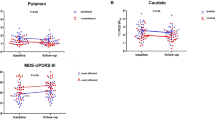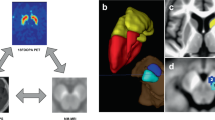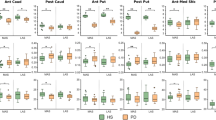Summary
This paper gives an overview of the clinical importance of SPECT and PET imaging of the dopaminergic system in the differential diagnosis and for the determination of the progression rate of Parkinson's disease (PD). D2 receptor imaging can help to differentiate multiple system atrophy (MSA) and progressive supranuclear palsy (PSP) from PD. In patients treated with neuroleptics it is possible to determine the rate of striatal D2 receptor blocking using this technique. This occupancy rate parallels the occurrence of parkinsonian side effects. Its measurement helps in the selection of newer atypical neuroleptics, which can be used to treat drug-induced psychosis in PD because they do not aggravate parkinsonian symptoms. Imaging of dopaminergic neurons with [123I]β-CIT SPECT or [18F]DOPA PET is a way to visualize and quantify the nigrostriatal dopaminergic lesion in PD. Findings correlate with clinical rating scales and demonstrate the feasibility of detecting the preclinical lesion in patients with hemiparkinson or familial PD. [123I]β-CIT SPECT can easily distinguish patients with essential tremor and patients with “lower body parkinsonism” due to a subcortical vascular encephalopathy. MSA and PSP cannot be separated from PD with this method alone. Longitudinal studies with [123I]β-CIT SPECT and [18F]DOPA PET can quantify the progression rate in PS. SPECT results from our own group show a low rate of progression in patients with a long duration of disease and a more marked progression rate in patients with shorter disease duration. In the former groups regions in the striatum with higher β-CIT binding at the time of the first SPECT scan decline faster than regions with lower binding. These findings suggest a curvilinear course of progression which starts at different time points in different striatal regions and which levels off after several years of disease duration. These findings are in line with data from PET studies and underline the importance of an early start of neuroprotective strategies. Preliminary data from PET and SPECT studies in early PD suggest that dopamine agonists might have a slight neuroprotective effect and might slow down the rate of progression of the disease.
Similar content being viewed by others
Author information
Authors and Affiliations
Rights and permissions
About this article
Cite this article
Brücke, T., Djamshidian, S., Bencsits, G. et al. SPECT and PET imaging of the dopaminergic system in Parkinson's disease. J Neurol 247 (Suppl 4), IV2–IV7 (2000). https://doi.org/10.1007/PL00007769
Issue Date:
DOI: https://doi.org/10.1007/PL00007769




